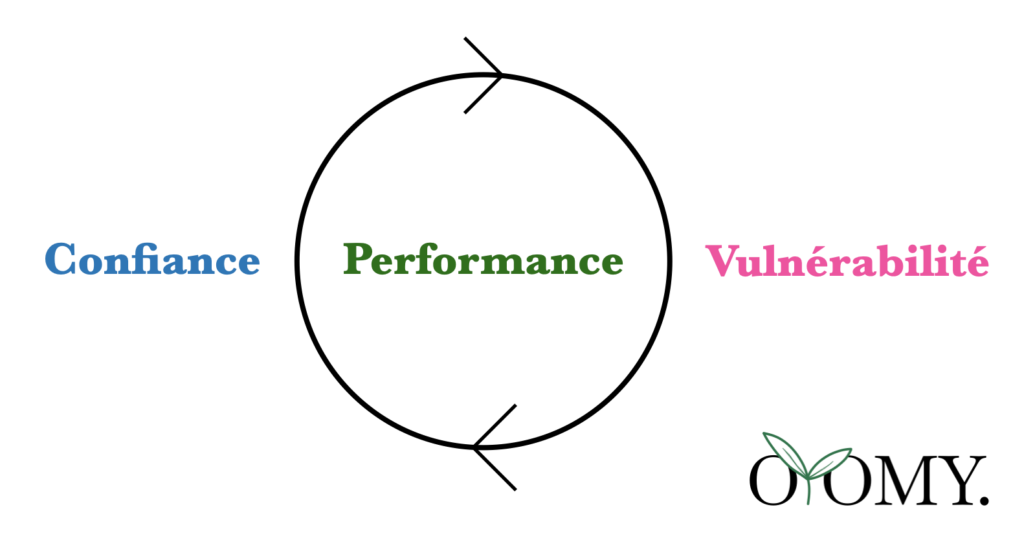
Vous êtes-vous déjà demandé ce qui sépare une équipe qui excelle d’une autre qui stagne ? Ou pourquoi certaines organisations ont des employés passionnés et créatifs tandis que d’autres luttent contre le turnover et la démoralisation? La clé se trouve dans deux mots essentiels : Confiance et Vulnérabilité.
On pourrait penser que ces termes correspondent mieux à un cours de développement personnel qu’à une salle de réunion d’entreprise. Mais c’est loin d’être le cas. Les recherches et les études montrent que la confiance et la vulnérabilité sont les fondements d’équipes solides et épanouies. Et il ne s’agit pas seulement d’ambiance : nous parlons de performance, d’innovation et de capacité à s’adapter dans un monde changeant.
Dans cet article, nous allons explorer ces idées, soutenues par les travaux de Brené Brown sur la vulnérabilité.
Alors, si vous souhaitez libérer le plein potentiel de votre équipe et ouvrir la voie à plus de succès, continuez votre lecture.
Le Pouvoir de la Vulnérabilité

La vulnérabilité, telle que définie par Brené Brown, est :
Le courage de montrer son vrai soi aux autres, de partager ses peurs, ses désirs, et ses imperfections.
C’est le terreau du courage, de la compassion et du changement positif.
La Vulnérabilité Comme Source de Courage

Selon Brown, la vulnérabilité n’est pas une faiblesse, mais plutôt une mesure de courage.
Oser être vulnérable, c’est oser être soi-même dans un monde qui nous pousse souvent à porter des masques.
C’est le courage de dire « je t’aime » en premier, le courage de demander de l’aide, ou même de dire que l’on ne sait pas quelque chose.
Elle nous propose un renversement de perspective en suggérant que la vulnérabilité est la source de toute émotion et sentiment authentique.
Pour Brown, derrière chaque acte de courage, il y a une certaine forme de vulnérabilité.
Prenons l’exemple d’un manager qui avoue à son équipe qu’il ne connaît pas la solution à un problème complexe.
Au lieu de perdre la confiance de son équipe, il gagne leur respect pour son honnêteté et ouvre la porte à une collaboration pour trouver une solution ensemble.
Quel est le dernier risque que vous avez pris ?
Avez-vous choisi la sécurité ou avez-vous osé être vulnérable?
La Vulnérabilité comme Catalyseur de Connexion Humaine

La vulnérabilité est le catalyseur de la connexion humaine. En effet, Brown souligne que nous sommes câblés pour la connexion. Nous avons un besoin inné de créer des liens avec d’autres personnes. La connexion authentique nécessite une vulnérabilité réciproque.
La connexion authentique, cette interaction profonde et significative avec autrui, est au cœur de notre bien-être émotionnel et psychologique.
Lorsqu’un ami partage une histoire personnelle difficile, il crée un espace pour une connexion plus profonde, car il vous montre non seulement ses triomphes mais aussi ses luttes.
| Note : Le livre « Social » de Matthew D. Lieberman explore les bases neurologiques de notre besoin de connexion. |
Avez-vous créé de l’espace pour la vulnérabilité dans vos relations ?
Pourquoi ne pas initier cette connexion aujourd’hui?
La Vulnérabilité et l’Importance de l’Empathie

L’empathie est la capacité de comprendre et de partager les sentiments de quelqu’un d’autre, et elle est essentielle pour établir des relations profondes et authentiques.
L’empathie est le pont qui permet la connexion authentique. Elle crée de ce fait un espace sécurisé pour la vulnérabilité.
Si un membre de votre équipe vous fait part de ses incertitudes sur un projet, une réponse empathique comme « Je comprends à quel point cela peut être difficile, mais je suis ici pour t’aider » peut renforcer la confiance et la connexion au sein de l’équipe.
| Note : Dans son livre « Empathie« , Roman Krznaric défend l’idée que notre cerveau est programmé pour la connexion sociale : l’empathie serait au coeur de la nature humaine et une qualité essentielle à développer au XXIème siècle. |
Quand avez-vous fait preuve d’empathie pour la dernière fois?
Essayez de pratiquer l’empathie active cette semaine.
Le Lien entre Confiance et Vulnérabilité

Dans une équipe forte et épanouie, confiance et vulnérabilité sont étroitement liées et fonctionnent ensemble.
En effet, ces deux facteurs sont comme les deux faces d’une même médaille, chacun renforçant et alimentant l’autre de façon complémentaire.
La Confiance Permet la Vulnérabilité
La confiance est souvent la première étape dans la création d’un environnement où la vulnérabilité est possible. Cela est d’ailleurs parfaitement décrit dans les 5 dysfonctionnements d’une équipe de Patrick Lencioni.
Dans une équipe où règne la confiance, les membres se sentent en sécurité pour partager leurs idées, leurs inquiétudes et leurs échecs sans craindre de répercussions négatives.
Ce sentiment de sécurité psychologique est la condition préalable à toute forme de vulnérabilité véritable.
Lorsqu’un leader peut créer cette culture de confiance, il ouvre la voie à la vulnérabilité. Les membres de l’équipe sont plus enclins à partager leurs faiblesses, à demander de l’aide quand ils en ont besoin, et à accepter la critique constructive.
La Vulnérabilité Renforce la Confiance
La vulnérabilité agit comme un catalyseur pour approfondir la confiance au sein de l’équipe.
En effet, lorsque les membres de l’équipe partagent des expériences difficiles ou avouent leurs erreurs et leurs limites, ils offrent un cadeau d’authenticité aux autres. Cette authenticité, lorsqu’elle est accueillie et valorisée, crée un niveau de confiance encore plus profond.
Dans un environnement où la vulnérabilité est encouragée, les membres de l’équipe sont plus susceptibles de faire preuve d’empathie et de compréhension mutuelle, des composantes essentielles de la confiance durable.
Les Cycles Vertueux de Confiance et de Vulnérabilité

La relation entre la confiance et la vulnérabilité n’est pas linéaire mais cyclique. La confiance engendre la vulnérabilité, qui à son tour approfondit la confiance, créant un cycle vertueux d’amélioration continue.
Ainsi, ce cycle devient la pierre angulaire sur laquelle l’équipe peut bâtir d’autres qualités essentielles telles que la coopération, la créativité et, finalement, l’excellence.
Une Équipe Forte et Épanouie : Le Résultat Final

Dans une équipe où la confiance et la vulnérabilité sont intégrées dans la culture, les avantages sont nombreux.
En effet, la résolution de problèmes devient plus efficace, la satisfaction au travail augmente et l’innovation fleurit.
Les membres de l’équipe se sentent également valorisés et soutenus, ce qui augmente leur engagement et leur performance globale.
En résumé, la confiance et la vulnérabilité sont non seulement les clés d’une équipe forte et épanouie mais également les fondations sur lesquelles une organisation peut bâtir son succès à long terme.
Par où commencer ?

Créer une culture d’équipe qui valorise la confiance et la vulnérabilité peut être un défi, mais les avantages en justifient l’effort. Voici quelques conseils pratiques pour vous y aider :
1. Définir les Attentes et les Valeurs
Établissez clairement les attentes pour chaque membre de l’équipe et les valeurs qui régissent le groupe.
Cette transparence initiale est le premier pas vers la construction de la confiance.
2. Créer un Environnement Sûr
Fournissez un espace sûr où les membres peuvent exprimer leurs opinions, idées et préoccupations sans crainte de jugement ou de représailles.
Cela encouragera les membres à s’ouvrir et à montrer leur vulnérabilité.
3. Être Exemplaire dans votre Rôle
En tant que leader, montrez-vous comme un exemple de confiance et de vulnérabilité.
Admettez vos erreurs, demandez de l’aide quand vous en avez besoin et restez ouvert aux commentaires.
4. Promouvoir l’Écoute Active
Encouragez tous les membres à écouter activement, à poser des questions pour clarifier et à donner un feedback constructif.
Cela crée un environnement où les personnes se sentent entendues et valorisées, ce qui à son tour renforce la confiance.
5. Célébrer les Succès et Apprendre des Échecs
Prenez le temps de célébrer les réussites de l’équipe et des individus.
Également, abordez les échecs comme des occasions d’apprendre, pas comme des fautes à punir.
6. Faciliter des Moments de Partage
Organisez des sessions de partage où les membres peuvent discuter de leurs expériences, défis et préoccupations.
Cela peut être dans un format formel comme une réunion d’équipe, ou plus informel comme des sorties d’équipe ou des déjeuners.
7. Être Cohérent
La confiance se construit à travers la cohérence.
Pour ce faire, il est crucial d’être cohérent non seulement dans vos actions, mais également dans vos décisions et dans la manière dont vous traitez chaque membre de votre équipe.
8. Suivre et Mesurer
Mettez en place des métriques ou des enquêtes pour évaluer les niveaux de confiance et de vulnérabilité au fil du temps.
De cette manière, vous pourrez plus facilement suivre les progrès et ajuster vos méthodes si nécessaire.
Conclusion

En conclusion, la confiance et la vulnérabilité ne sont pas de simples mots : ce sont les fondements d’une équipe prospère. En les cultivant, vous ouvrez la voie à une transformation profonde, donnant à chaque membre l’opportunité de briller.
Alors, le moment est venu de passer à l’action. Vous avez les clés, maintenant il s’agit d’ouvrir les portes.
D’ailleurs, peu importe où vous en êtes dans votre parcours, chaque effort compte. Et les bénéfices ? Imaginez une équipe plus heureuse, plus engagée et plus efficace. Le jeu n’en vaudrait-il pas la chandelle ?
Ainsi, chaque grand voyage commence par un petit pas. Si jamais l’idée de débuter cette transformation vous semble complexe ou intimidante, n’hésitez pas à me contacter pour obtenir conseils et orientations.
Votre équipe mérite le meilleur, et ce meilleur commence avec vous !






